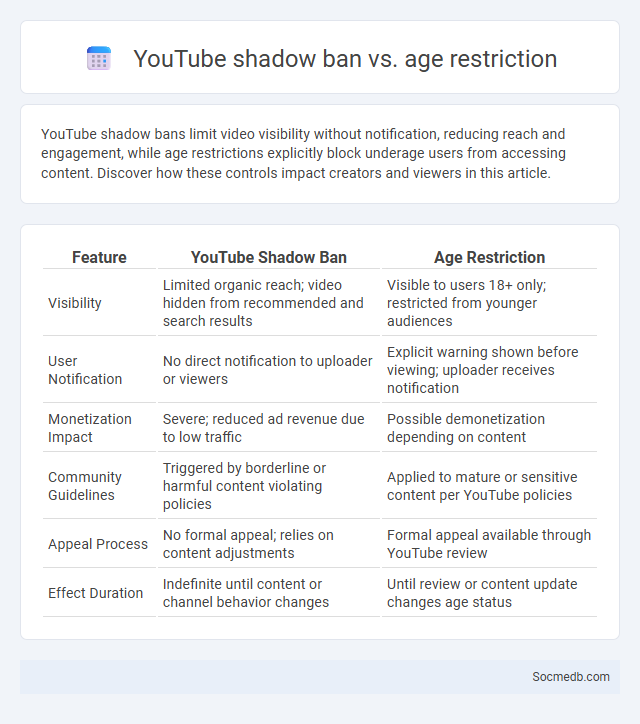
Photo illustration: YouTube shadow ban vs age restriction
YouTube shadow bans limit video visibility without notification, reducing reach and engagement, while age restrictions explicitly block underage users from accessing content. Discover how these controls impact creators and viewers in this article.
Table of Comparison
| Feature | YouTube Shadow Ban | Age Restriction |
|---|---|---|
| Visibility | Limited organic reach; video hidden from recommended and search results | Visible to users 18+ only; restricted from younger audiences |
| User Notification | No direct notification to uploader or viewers | Explicit warning shown before viewing; uploader receives notification |
| Monetization Impact | Severe; reduced ad revenue due to low traffic | Possible demonetization depending on content |
| Community Guidelines | Triggered by borderline or harmful content violating policies | Applied to mature or sensitive content per YouTube policies |
| Appeal Process | No formal appeal; relies on content adjustments | Formal appeal available through YouTube review |
| Effect Duration | Indefinite until content or channel behavior changes | Until review or content update changes age status |
Understanding YouTube Shadow Banning
YouTube shadow banning limits your content's visibility without notifying you, reducing your reach and engagement on the platform. Videos might not appear in search results, recommendations, or subscriber feeds due to policy violations or algorithmic triggers. Understanding these restrictions helps you adapt your content strategy to maintain audience growth and compliance with YouTube's guidelines.
What is Age Restriction on YouTube?
Age restriction on YouTube limits access to videos that may contain mature content unsuitable for viewers under 18 years old. This feature helps protect younger audiences by requiring users to sign in and verify their age before watching such content. You can manage and understand these restrictions to ensure your viewing experience aligns with YouTube's safety policies.
Key Differences: Shadow Ban vs Age Restriction
Shadow ban limits Your content visibility without notification, covertly reducing engagement by hiding posts from non-followers or search results. Age restriction enforces content access based on a user's verified age, ensuring compliance with legal guidelines and protecting younger audiences. Both impact reach, but shadow bans affect a broader audience unknowingly, while age restrictions target specific age groups explicitly.
How Does YouTube Shadow Ban Work?
YouTube shadow banning limits the visibility of your videos without notifying you, reducing their reach in search results, recommendations, and subscriber feeds. This often occurs when content violates community guidelines or spam policies, triggering algorithmic restrictions that make your channel less discoverable while maintaining normal user access. Understanding these hidden penalties helps you adjust your content strategy to improve engagement and avoid reduced exposure.
Impact of Age Restrictions on Content Visibility
Age restrictions on social media platforms significantly influence content visibility by limiting access to certain age groups, which reduces overall reach and engagement metrics. These restrictions often result in older users bypassing specific content, while younger audiences face barriers that can decrease exposure to important information or trends. Platforms employ algorithms that prioritize age-appropriate content, affecting how posts are distributed and discovered within different demographic segments.
Shadow Banning: Effects on Channel Performance
Shadow banning on social media significantly reduces a channel's visibility by limiting content reach without notifying the user, leading to decreased engagement and follower growth. This covert restriction impacts algorithmic distribution, causing analytics like impressions, likes, and shares to drop sharply. Content creators often experience stalled audience expansion and diminished revenue opportunities due to reduced discoverability and interaction metrics.
Signs Your YouTube Video is Shadow Banned
A sudden drop in video views and engagement without explanation often indicates your YouTube video is shadow banned. Lack of appearance in search results or recommendations despite relevant keywords signals restricted visibility. Monitoring analytics for consistent viewer discrepancies helps confirm potential shadow banning on YouTube.
Reasons Behind YouTube Age Restrictions
YouTube age restrictions are implemented to protect minors from content that may be inappropriate, such as explicit language, violence, or adult themes. These restrictions ensure compliance with laws like COPPA (Children's Online Privacy Protection Act) and help maintain a safer online environment. Understanding these rules helps you navigate YouTube's content responsibly and avoid exposure to harmful material.
Avoiding Shadow Bans and Age Restrictions
To avoid shadow bans and age restrictions on social media, ensure your content strictly adheres to platform guidelines by avoiding sensitive or prohibited topics and maintaining authentic engagement without spammy behavior. Use accurate age information in your profile settings and refrain from posting content flagged for adult or inappropriate themes. Your consistent compliance protects account visibility and access to all platform features.
Best Practices for Compliant YouTube Content
Creating compliant YouTube content requires adherence to platform policies, including copyright rules, community guidelines, and advertiser-friendly content standards. You should ensure your videos avoid prohibited material such as hate speech, misinformation, and inappropriate content, while also providing proper attribution for any third-party assets used. Consistently monitoring YouTube's updates and employing accurate metadata helps optimize visibility and maintain compliance.
 socmedb.com
socmedb.com